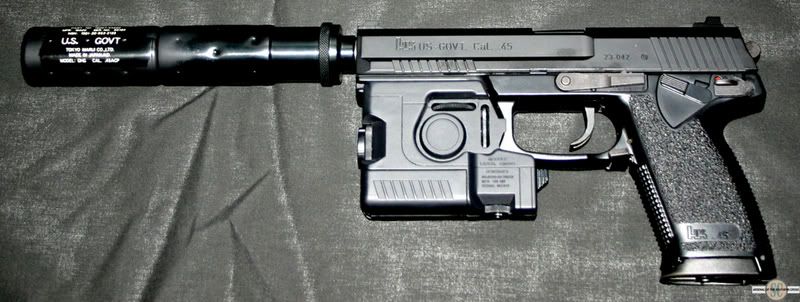While the designation applies to the complete system, it's also commonly used in reference to the pistol component itself. The pistol itself, chambered for the .45 ACP cartridge, was developed by Heckler & Koch, and was selected over the Colt OHWS through USSOCOM's Offensive Handgun Weapon System (OHWS) program. The LAM and suppressor were developed by Insight Technology and Knight's Armament Company (KAC), respectively.
The MK23 Mod 0 was built as an "offensive" handgun for U.S. special operations forces under USSOCOM, as per request made in 1989. Military versions of the firearm have the writing "MK23 USSOCOM" engraved on the slide.
The MK23 is considered a match grade pistol, and is capable of making a 2-inch (51 mm) group at 50 yards (46 m), roughly 4 MOA. Production began in 1991, and it was the basis for the HK USP, which began production in 1993. The MK23 has exceptional durability in harsh environments, being waterproof and corrosion-resistant. It uses a polygonal barrel design, which is reported to improve accuracy and durability. It also features an ambidextrous safety and magazine release on both sides of the frame. The magazine release is at the rear edge of the trigger guard, which is wide enough to allow the use of gloves. A decocking lever is on the left side, which will silently lower the cocked hammer. The MK23 is part of a larger weapon system that includes an attachable laser aiming module, a suppressor, and some other features such as a special high-pressure match cartridge (.45 +P ammunition).
The firearm was tested and found to be capable of firing tens of thousands of rounds without a barrel change. It remains reliable in harsh conditions, making it suitable for use by special forces. The .45 ACP round has considerable stopping power, and yet is subsonic making it suitable for use with a suppressor.
However, the firearm's large size and weight have resulted in some criticism. In response, HK developed the USP Tactical pistol based on the original USP; the Tactical retains much of the performance of the MK23 without the bulky size, but is not able to use the suppressor (due to opposite threading directions) or the LAM. An even more compact pistol than the USP Tactical for counter-terrorist and special forces use is the new HK USP Compact Tactical, which does have its own optional LAM. The USP-CT is lighter and is capable of fitting a suppressor, making it a prime choice for Special Forces on covert operations.
The proposed Joint Combat Pistol (JCP) was intended to accept match grade and +P ammunition. However, it is not clear if the JCP, which absorbed the earlier SOF Combat Program, will be used alongside or replace the MK23 handguns. As of 2006, the JCP has since been renamed and restructured.
Offensive Handgun Weapon System
The MK23 was submitted to the USSOCOM Offensive Handgun Weapon System (OHWS) competition around late 1991 the goal of which was to create an entire pistol package capable of replicating the performance of longer barreled weapons such as submachine guns with many customizable features. Its rival was the Colt OHWS. Though both Heckler & Koch's and Colt's designs were tailored to the demanding requirements of the OHWS competition, the MK23 eventually won.HK commercially markets the MK23 and derivatives of it, but not the complete SOCOM system. The suppressor is made by Knight's Armament Company, and was selected over the one HK originally included as part of its entry. Insight Technology won the contract to produce the laser aiming module, later designated AN/PEQ-6. One version of the LAM produces a visible light dot, while another produces an infrared dot that can only be seen through night vision goggles. There have since been different LAM models and, at least commercially, different suppressors as well. The first MK23 production models were delivered to SOCOM on May 1, 1996. At last count, 1,986 units were built (serial numbers 23-0101 through 23-2086). It has been reported by some users that the cumulative effects of recoil may occasionally cause the can of the suppressor to become slightly unscrewed, but that it is relatively easy to improvise solutions for the problem. Other users say the pistol's large frame size means its wide grips are not always comfortable for people with smaller hands. Today some special operators choose to use the HK USP Tactical Model instead, because it has a pistol grip that is not so wide and can help to avoid this problem citation needed.







No comments:
Post a Comment